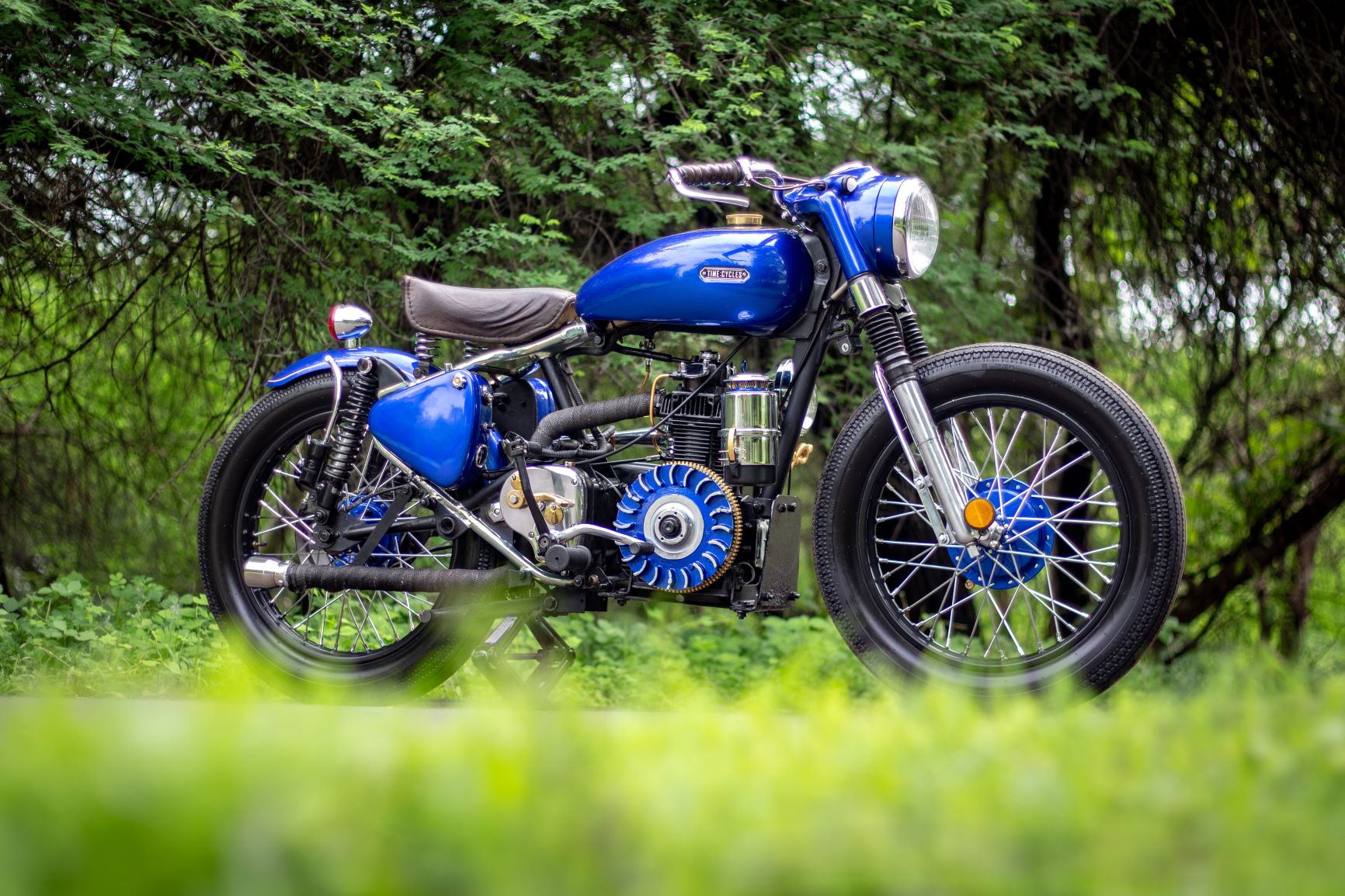This 1959 diesel-powered Royal Enfield resto-mod can achieve 75kmpl!
A closer look into an engine-swapped Royal Enfield custom built by custom bike builder Time Cycles
 The Indigo paintjob on this custom build is a stunner!
The Indigo paintjob on this custom build is a stunner!Royal Enfield motorcycles have been the focus of many a custom bike, with the manufacturer itself recognising and featuring on its website the wide variety of custom jobs done on its motorcycles. This can be attributed to the fact that their bikes are conventionally easy to work with, thanks to their simple design and engineering when compared to most bikes in the market today.
But with most project bikes, the focus is usually on aesthetics. However, the project bike we see here seems to take the very idea of customisation to a different (or should we say a consummate professional) level. This is because it was undertaken with a singular motive: to increase fuel efficiency, and involved, among other things, a complete engine swap!
 The custom butterfly bar and insribed design on the tank of Navilu
The custom butterfly bar and insribed design on the tank of NaviluThe donor bike, a 1959 Royal Enfield Standard model, was obtained by Time Cycles, a custom motorcycle garage based in Mhow, Madhya Pradesh, specialising in motorcycle restorations. And this is more than just a chopper-and-bobber factory, the kinds we see aplenty on social media. A glimpse at Time Cycles’ instagram page reveals Shashank, the owner of the establishment, harbours a deep-rooted love for both aesthetics as well as the mechanical know-how of two-wheeled vehicles, irrespective of engine size or layout. For his part, Shashank chose the G2 as this particular model line was renowned for its robust nature and retro looks, a point driven home by the flipped positions for its gear and brake levers, as was the case with British bikes of the time.
Now, as mentioned, the project began by swapping the 350cc petrol motor for a 500cc air-cooled Greaves-Lombardini diesel engine. This engine, usually employed for agricultural (stationary) purposes, puts out 20Nm at about 1600pm, but an unimpressive 6.2bhp. However, this state of tune is perfectly aimed at stretching efficiency figures, as Shashank indicated the motor could deliver about 73-75kmpl. Repurposing it for automotive purposes, however, meant a top-down overhaul.
Out went the bearings and piston, followed by the exhaust and intake valves being swapped, so the engine could breathe cooler air. The air filter was also replaced with an oil-filtered air cannister at the front. The clutch was then rebuilt to accommodate more plates to handle the bike’s four-speed gearbox. And, considering the engine was already making abundant torque, a larger custom-made 19T front sprocket was installed for easier revs and slightly more power in the mid-to-top range. Finally, the engine cover was trashed to expose the flywheel; a dangerous but flamboyant move. The exhaust, too, was redesigned to use a two-pipe setup fitted seamlessly to look as one.
 Navilu's exposed flywheel and the retro-themed oil cannister air filter
Navilu's exposed flywheel and the retro-themed oil cannister air filterWith headway made in the drivetrain department, the attention shifted to the body. Shashank’s team binned most of the bike’s parts, including the airbox, mudguards and chainguard, to shed weight as well as keep with the ‘bobber’ motif. The shock absorbers were replaced with new OEM gas shocks, to improve damping and lower the bike by two inches. The stock wheels were then shod with Shinko 4.00-19-inch tyres, a big step up from the stock 3.25-19s usually seen on the donor.
Next, the handlebar was switched out for a period-correct butterfly-style ‘bar with custom made bar finished in chrome, with the end-mounted levers in brass. Next, the seat was replaced with an old-school springer saddle finished in handcrafted tan leather, completing the bobber aesthetic Shashank had envisioned.
Before getting the bike fired up, a thorough check of the electrical system was in order. The stock electricals consisted of a 6V system, but then was replaced with a custom alternator and handmade wiring loom which birthed a 12V electrical system, capable of running 200W on demand. The old filament headlight bulb was replaced with a Philips H4 LED bulb, with an additional 100W fog light, and a pair of Philips H4 Rally bulbs (for riding/ touring in inclement weather). The stock-mounted indicators were then dropped and the pilot lights above the headlamp were repurposed as the turn signals. Finally, a Hella trumpet horn was installed.
With the bike now in running order and being taken out for test rides, Shashank was pleasantly surprised with the jaw-dropping reactions from the people on the road. He correlated the fact that they seemed both impressed and intrigued with the kind of reaction people give to the sight of a dancing Peacock. To that end, he decided to incorporate a peacock feather in the redesigned speedometer dial as well as in the ampere meter casing, which now held a quartz watch.
 The peacock-feathered dials perfectly compliment the Axalta Indigo color scheme
The peacock-feathered dials perfectly compliment the Axalta Indigo color schemeStaying with the Peacock theme, Shashank disassembled the bike and sent most of it to be enveloped in a new Axalta indigo colour, which best represents the Indian Peacock. A few other parts like the front brake cam, part of the flywheel, wheel hubs, fog light mount, air filter and the diesel fuel line were carefully hand-painted in gold. Finally, everything was sent to 3M for paint protection. The finished product was christened ‘Navilu’, the Kannada word for peacock.
The team at Time Cycles is currently working on a café racer build based on a Yamaha RX 135 and an ergonomic revamp to a vintage Rajdoot. Besides, Shashank plans to build a dual-engined diesel Bullet in the foreseeable future to satisfy his need for more torque.
You can find Time Cycles on Instagram here.


